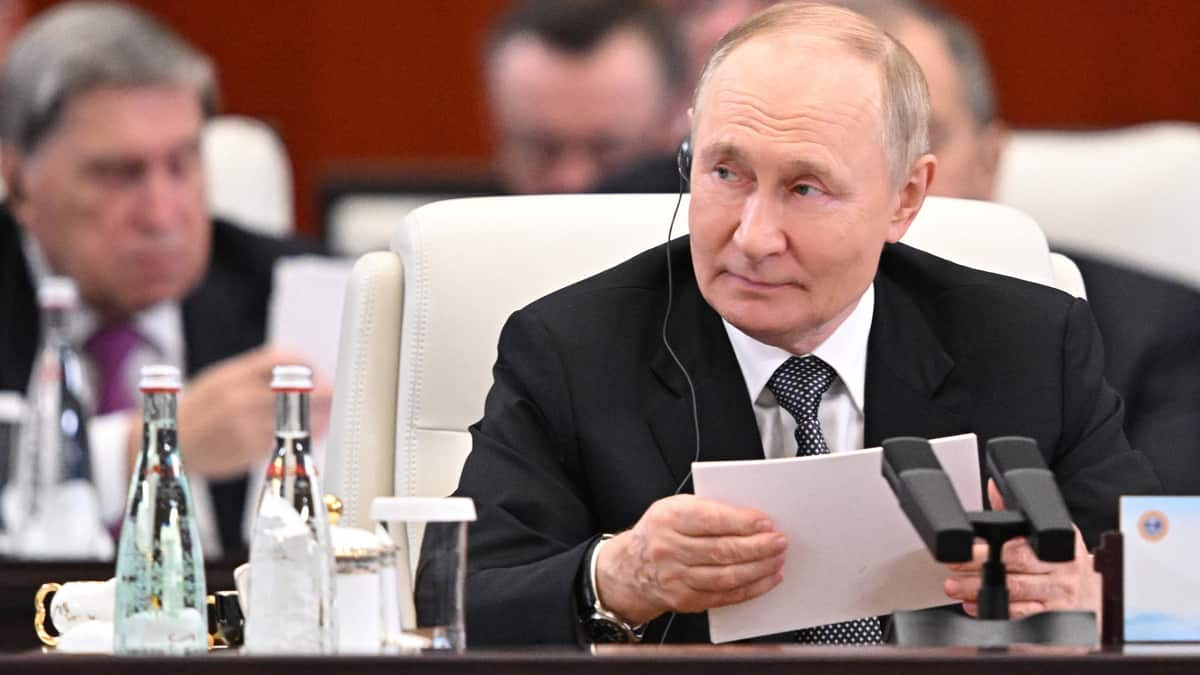Politics
Putin Escalates Tensions as Russian Jets Violate NATO Airspace

Russian President Vladimir Putin has openly escalated tensions with NATO, particularly in light of recent military actions that have provoked swift responses from the alliance. On September 25, 2023, a formation of Russian aircraft, including three MiG-31s, a Su-30SM, and a Su-35, was spotted over the Baltic Sea, prompting the Hungarian Air Force to scramble two JAS-39C Gripens from Lithuania to intercept the jets. This incident is the latest in a series of provocative airspace violations that have alarmed NATO members.
The day prior, on September 24, two Russian Tu-95 long-range strategic nuclear bombers, accompanied by two nuclear-capable Su-35 fighters, were detected near the Alaskan Air Defense Identification Zone (ADIZ). Although such incursions are not new, they have raised concerns among U.S. and Canadian military officials. In response, the North American Aerospace Defense Command dispatched four F-16s, an E-3 early warning and control aircraft, and four KC-135 tankers to identify and intercept the Russian aircraft.
Growing Airspace Violations and Military Maneuvers
The presence of Russian warplanes in the ADIZ has become increasingly common, yet it has not gone unnoticed. Recent months have seen a string of incidents, including the sighting of a Russian reconnaissance aircraft, IL-20 COOT, multiple times in the ADIZ and an alarming video from September 2024 showing a Russian Su-35 engaging in unsafe maneuvers near NORAD aircraft.
NATO’s air policing operations have responded robustly, as seen when three Russian MiG-31s entered Estonian airspace over the Gulf of Finland, prompting quick action from Italian F-35s stationed in the region. Other breaches have included drones and aircraft violating airspace over Romania and Poland, highlighting the persistent threat posed by Russian military activities.
Military analysts suggest that these violations may serve as tests of NATO’s preparedness amid ongoing support for Ukraine, which has been embroiled in conflict with Russia for over three years. Ukrainian President Volodymyr Zelensky characterized these actions as a clear escalation of the war, asserting that they reflect Russia’s aggressive intent.
The Implications of Reflexive Control
The theory behind Russia’s actions may be rooted in the Soviet-era concept of ‘Reflexive Control,’ which aims to manipulate an adversary’s perception and compel them to act in ways that benefit Russian interests. This asymmetric warfare tactic relies on psychological and informational strategies to achieve geopolitical goals.
Experts argue that Putin’s strategy may involve testing NATO’s resolve before potentially targeting one of the six NATO member nations bordering Russia—namely Poland, Estonia, Norway, Lithuania, Latvia, and Finland. Such actions raise the stakes as NATO operates under Article 4, which allows for consultations when a member’s territorial integrity is perceived to be threatened.
Despite the heightened tensions, some military analysts believe that an outright attack on a NATO member would be a miscalculation for Russia, as it would invoke Article 5, resulting in a collective military response from the alliance.
The ongoing military exercises in Belarus, including simulated nuclear strikes, further underscore the precarious situation. These drills, which involved the deployment of nuclear-capable hypersonic missiles, have prompted NATO to remain vigilant and prepared for any potential escalation.
As NATO grapples with these developments, the reactions from member nations have revealed divisions regarding how best to respond to Russian provocations. While Eastern European countries advocate for a united front, calls for restraint from other NATO members complicate the alliance’s collective strategy.
Putin’s maneuvers, interpreted by some as nuclear blackmail, have sown uncertainty among NATO allies, particularly given the fluctuating U.S. commitment under former President Donald Trump. Trump’s contradictory statements regarding NATO’s role and support have emboldened Putin’s actions, as evidenced by his comments that suggested a willingness to encourage Russian aggression against NATO members that do not meet defense spending targets.
In summary, the recent increase in Russian military activity, including airspace violations and provocative maneuvers, poses significant challenges for NATO. As the alliance seeks to navigate this complex landscape, the potential for miscalculation or escalation remains a pressing concern.
-

 World5 months ago
World5 months agoSBI Announces QIP Floor Price at ₹811.05 Per Share
-

 Lifestyle5 months ago
Lifestyle5 months agoCept Unveils ₹3.1 Crore Urban Mobility Plan for Sustainable Growth
-

 Science4 months ago
Science4 months agoNew Blood Group Discovered in South Indian Woman at Rotary Centre
-

 World5 months ago
World5 months agoTorrential Rains Cause Flash Flooding in New York and New Jersey
-

 Top Stories5 months ago
Top Stories5 months agoKonkani Cultural Organisation to Host Pearl Jubilee in Abu Dhabi
-

 Sports4 months ago
Sports4 months agoBroad Advocates for Bowling Change Ahead of Final Test Against India
-

 Science5 months ago
Science5 months agoNothing Headphone 1 Review: A Bold Contender in Audio Design
-

 Top Stories5 months ago
Top Stories5 months agoAir India Crash Investigation Highlights Boeing Fuel Switch Concerns
-

 Business5 months ago
Business5 months agoIndian Stock Market Rebounds: Sensex and Nifty Rise After Four-Day Decline
-

 Sports4 months ago
Sports4 months agoCristian Totti Retires at 19: Pressure of Fame Takes Toll
-

 Politics5 months ago
Politics5 months agoAbandoned Doberman Finds New Home After Journey to Prague
-

 Top Stories5 months ago
Top Stories5 months agoPatna Bank Manager Abhishek Varun Found Dead in Well









